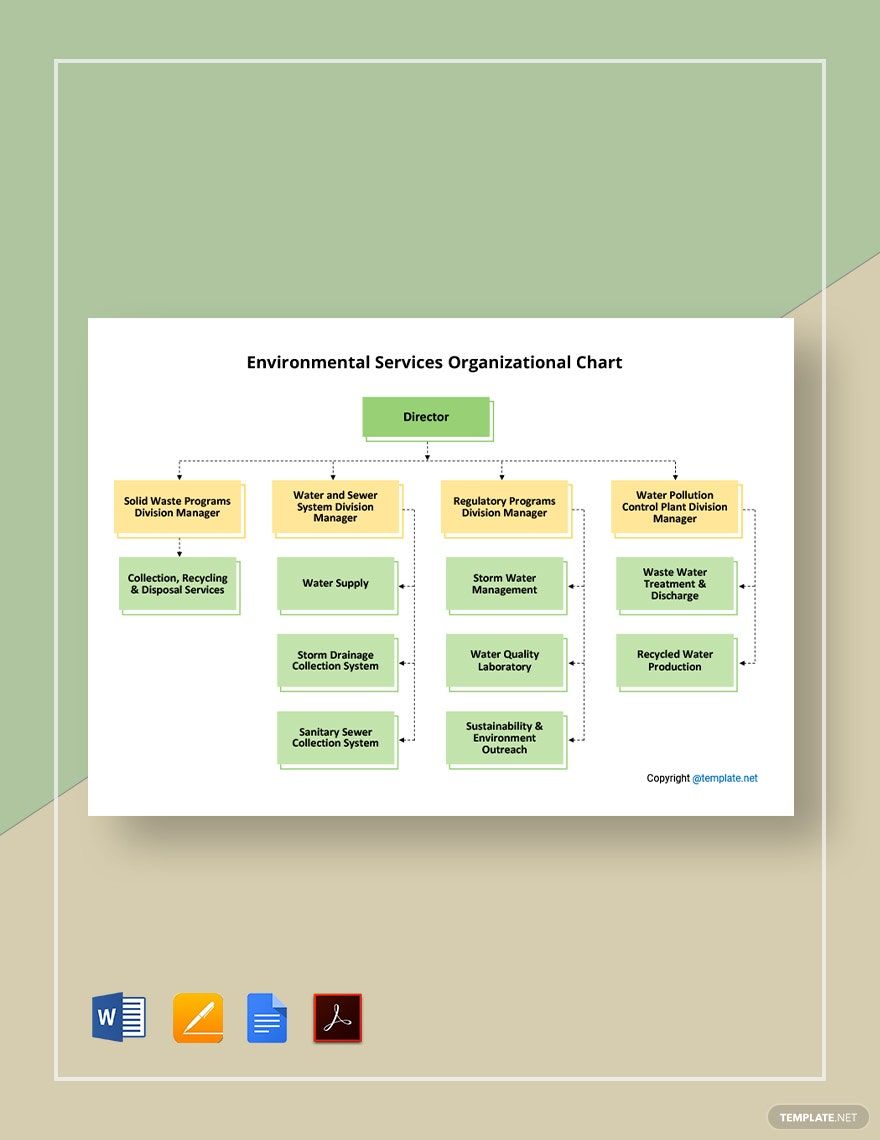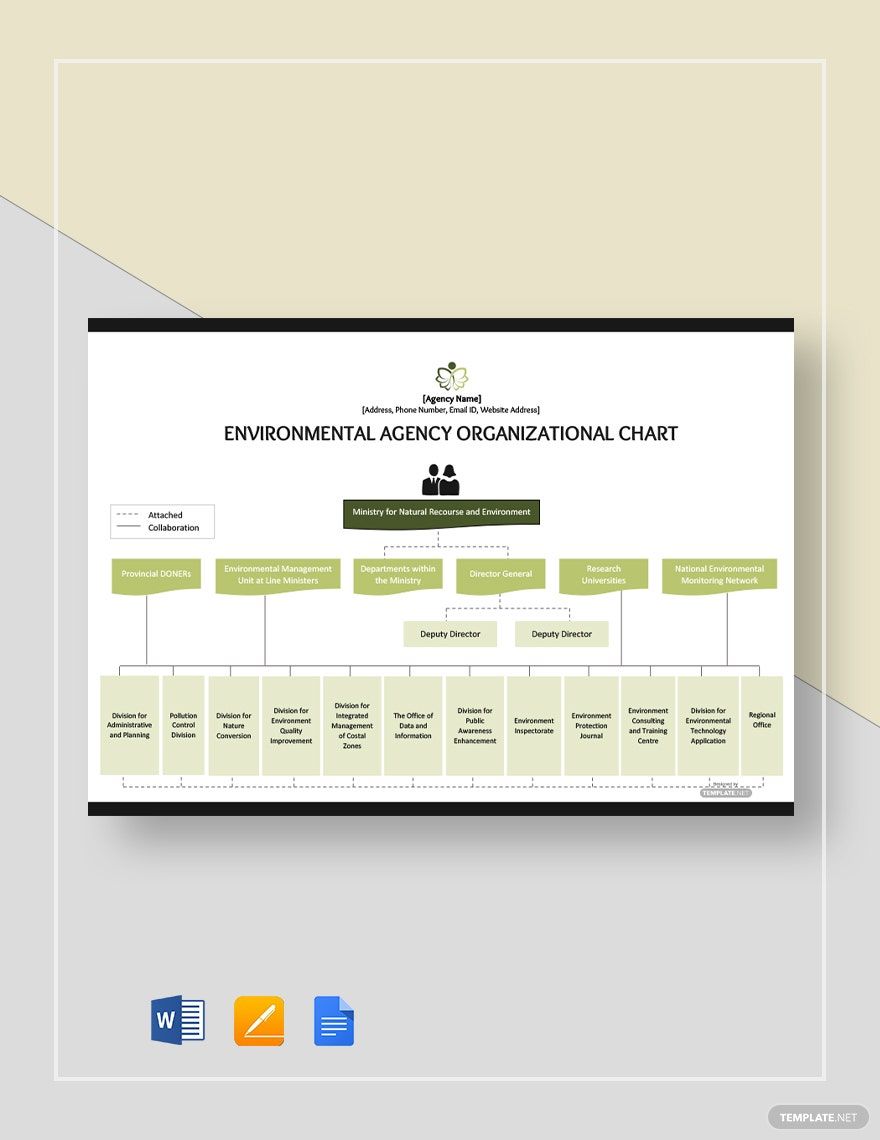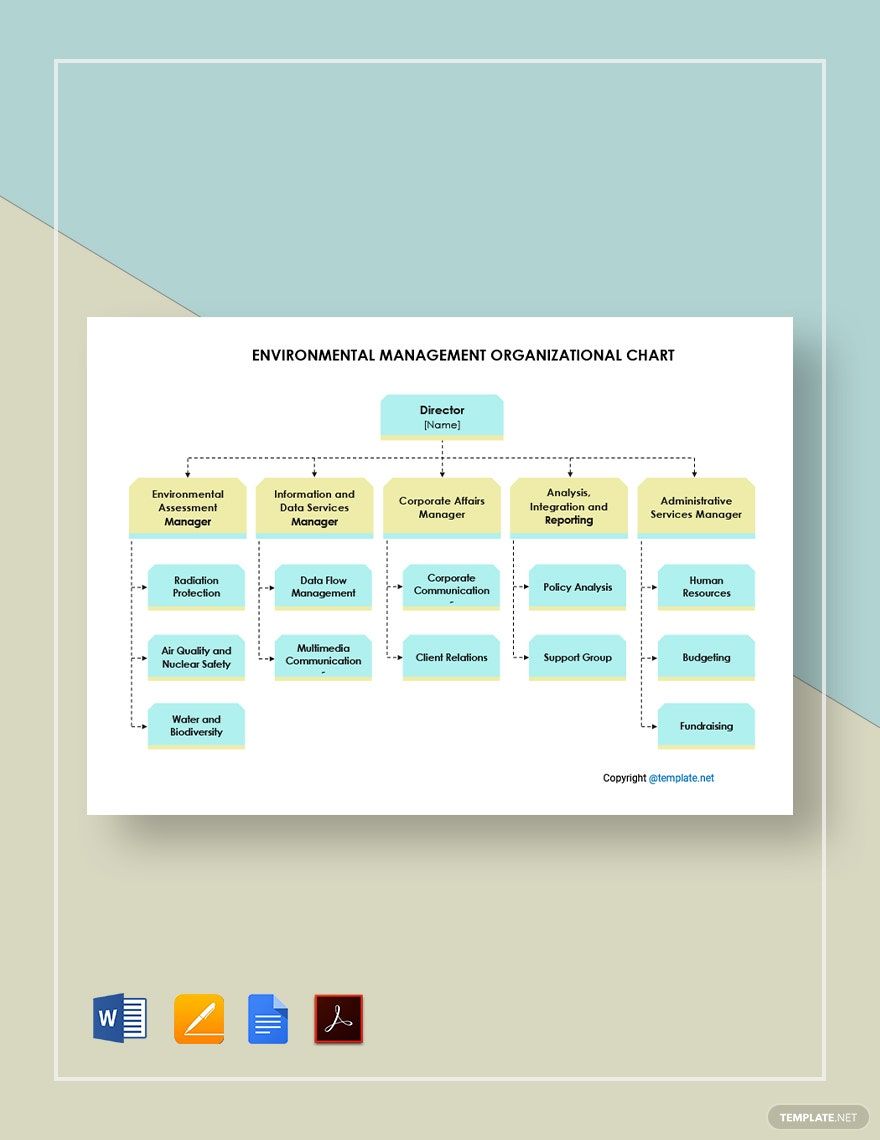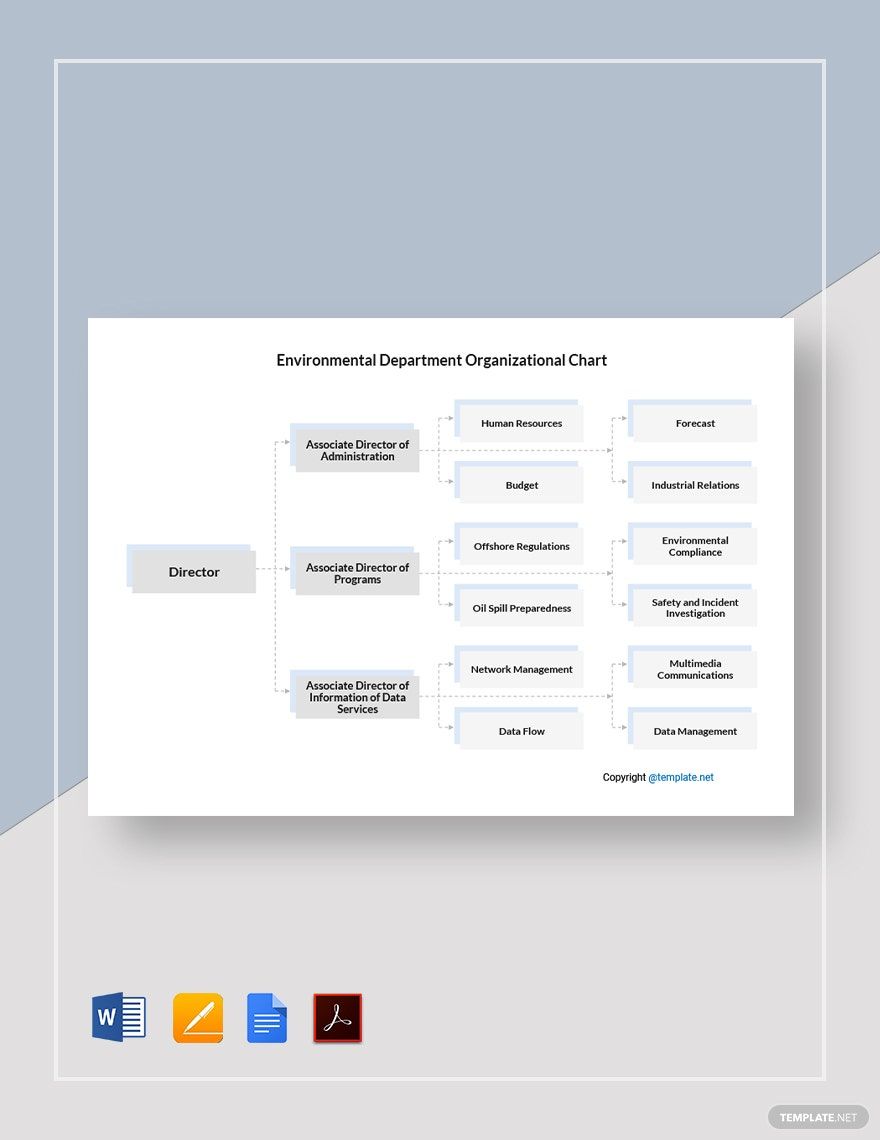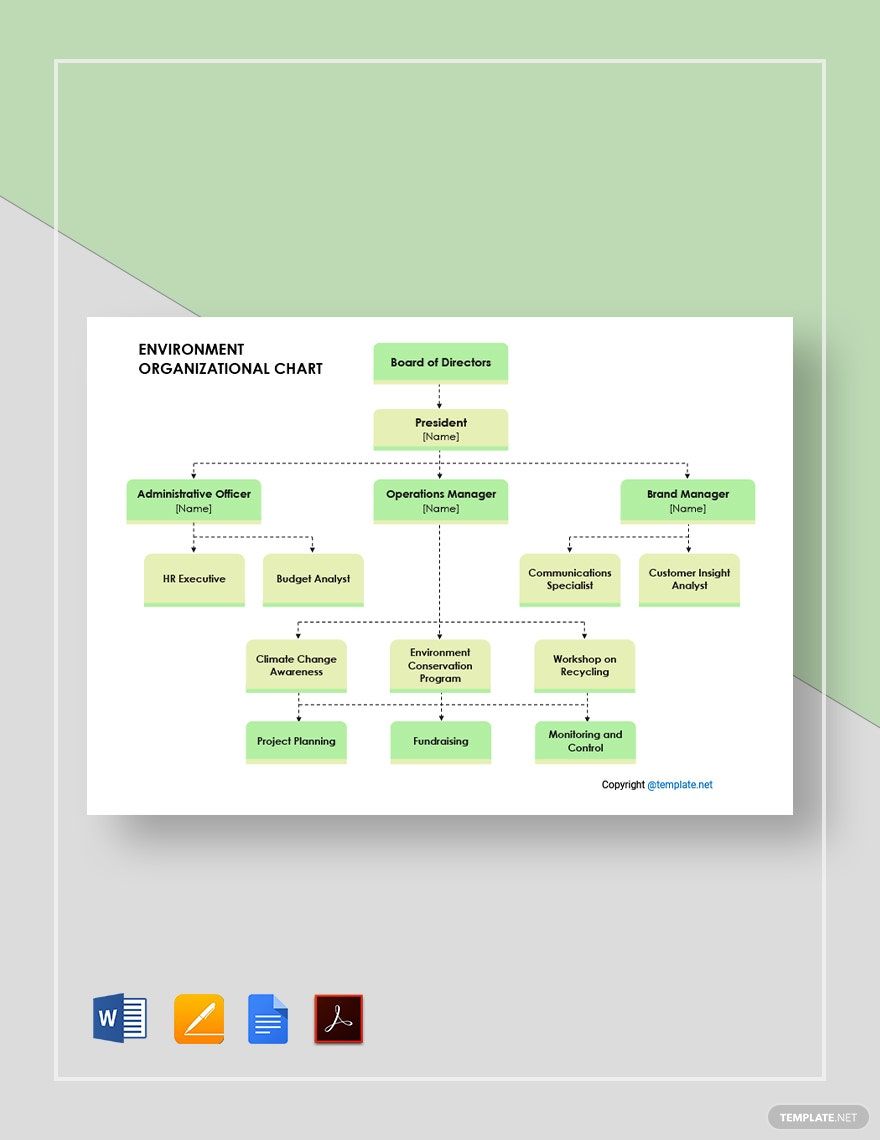There are countless groups and organizations around the globe for just about every advocacy. One of the more popular ones dedicate their time and resources to the environmental sciences and the fight against climate change. If you belong to such a group, then you can certainly make use of our Environment Organizational Chart Templates. Available is Google Docs, each one has a ready-made layout that you can customize for your own environmental agency. All you have to do is sign up, and you can download the template that best suits your preference. Check them out!
Environment Organizational Chart Template in Google Docs
Environmental Management Organizations Will Find Template.net’s Environment Organizational Charts Useful to Help Create Organizational Charts That Include Ready-Made Structures and Color Codes for Every Department, Including Health and Safety Matrix Teams. Choose from Blank, Simple, Basic, or Creative Designs You Can Fully Edit and Customize in the Commonly-Available Google Docs File and Download for Free.
- Business Plans
- Receipts
- Contracts
- Manual Templates
- Note Taking
- Forms
- Recommendation Letters
- Resignation Letters
- Birthday
- Outline
- Quotation
- Charts
- Handbook
- Family Tree
- Surveys
- Workout Schedule
- Study Guide
- Ebooks
- Chore Charts
- Training Manual
- Research
- Screenplay
- Wedding
- Lesson Plan
- Brief
- Organizational Charts
- Syllabus
- School Calendar
- Attendance Sheet
- Business Cards
- Student
- Review
- White Paper
- Essay Plan
- Vouchers
- Timeline Charts
- Reference
- Estimate Sheet
- Mind Map
- Cover Letters
- Interview
- Posters
- Report Cards
- Fax Covers
- Meeting Minutes
- Roadmaps
- Cookbook
- Curriculm Lesson Plan
- Bibiliography
- Rental Agreement
- Legal Templates
- Party
- Pleading Paper
- Pay Stub
- Classroom Seating Charts
- Sub Plan
- IT and Software ID Card
- Event Proposal
- Likert Scale
- Doctor Note
- Labels
- SOP
- Comparison Charts
- Project Reports
- Daily Schedule
- Weekly Calendar
- Customer Persona
- Medical
- Coupons
- Resumes
- Invoices
- Christmas
- List
- Executive Summary
- Marketing
- Budget
- Meal Plan
- Friendly Letters
- Itinerary
- Reference Letters
- Church
- Letters of intent
- Reading logs
- Assignment agreement
- Mothers day card
- Retrospective
- Simple loan agreement
- Rent Receipts
- One page business plan
- Weekly Reports
- Offer letters
- Prescription
- One page proposal
- Case brief
- Roster
- Log Sheets
- Music
- Schedule cleaning
- Printable survey
- Internship report
- Fundraising
- Research proposal
- Freelancer agreement
- Delivery note
- Madeline hunter lesson plan
- Training
- Social media calendar
- Catalogs
- Grant proposal
- Affidavit
- Lean business plan
- Schedule hourly
- Mon disclosure agreement
- Bill of lading
- Sitemap
- Campaign
- Education
- Cash Receipts
- Introduction letter
- It and software profile
- Business case
- Annual Reports
- Personal letter
- Calendar Google Docs
How to Make an Environment Organizational Chart in Google Docs
An article published in The Academy of Management Journal indicated a directly-proportional relationship between position worth and level in the managerial hierarchy. Members of any organization understand that a group operates within the management of its organizational structure. From planning strategy to dealing with external affairs, the decisions depend on the people who have the authority.
To ensure that your own organization clearly outlines the positions and relationships of each member, you have to create a comprehensive chart. The steps below will help you get started.
1. Finalize the Scope
Every organizational chart has to have a focus. You may choose to plot your entire group or just one specific part of it. Either way, make sure you finalize the scope before you begin. This will help you determine where to start and which particular members and positions to include.
2. Begin with the Highest Position
You are encouraged to start plotting your chart with the member who holds the highest position. That way, you can go down to the deputies and their respective subordinates. Make sure to list these details down before you plot them into a chart, so you can visualize how big the entire diagram is going to be.
3. Determine the Roles and Responsibilities
As you decide which positions to include next, keep in mind the roles and responsibilities of each member. You have to clearly outline who has the authority in the implementation of policies, approval of decisions, and delegation of tasks. Your chart has to reflect the actual hierarchy that your organization follows during activities and operations.
4. Identify the Relationships Between Members
Not all positions are created equal, so you have to ensure that the dynamics between the members are mapped out in your chart. Members placed on the same level with each other will need to have the same functional authority within the organization. There has to be an obvious difference between the responsibilities of a supervisor and a volunteer, for example.
5. Ensure a Balance
Charts are as much visual representations as they are reference for management and responsibilities. Keep all elements balanced. If you included four levels of position on one side, the same has to be applied to another. You may add functional designs afterwards, like colors and symbols, but make sure they don’t contradict or destroy the details presented.
Frequently Asked Questions
What is climate change?
Climate change pertains to the changes in global or regional climate patterns over time. These include long-term shifts in temperature and weather conditions as a result of external elements, such as man-made activities and infrastructures.
What is the difference between global warming and climate change?
According to NASA, global warming specifically refers to the increasing global temperature while climate change includes global warming, along with other changes in the environment, including rising sea levels and disrupted cycles in the planet’s flora and fauna.
What are the causes of climate change?
1. Carbon dioxide
2. Water vapor
3. Methane
4. Chlorofluorocarbons
5. Nitrous oxide
What are some of the organizations that focus on climate change?
1. Intergovernmental Panel on Climate Change
2. 350.org
3. Union of Concerned Scientists
4. Greenpeace
5. Climate Action Network
What is the difference between weather and climate?
Weather refers to changes in the atmosphere over a short period of time, while climate talks about long-term atmospheric conditions.

